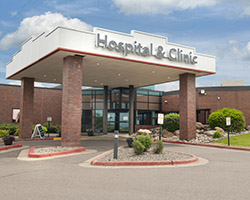
Hospital overview

Buffalo Hospital receives Minnesota Hospital Association safety award. Buffalo Hospital made it a priority to embrace a safety philosophy that empowered, motivated and rewarded leaders and staff for speaking up and stopping the line when something just didn’t feel right.
One of the things that I think is critical about creating a culture of safety is having an engaged staff. Your staff have to be critically engaged in all that you do at the hospital and they need to feel like they have a work environment that you support them in and you're looking out for their best interests and we want to make sure this culture is such that everyone feels comfortable speaking up, no matter if they’re new, if they’ve been here a long time, if they were feeling like they shouldn’t. They just need to be comfortable speaking up at any time.
We use a recording system called the PDSR, which is a patient visitor safety report, and that’s an electronic report that staff can fill out indicating that there’s been a safety event or a near misreport and so in the near misreports are really a way to show that the staff are recording events and that they feel comfortable speaking up and making sure that those events are known and so that we can make improvements in the future to help prevent those events from occurring again.
People feel like they have a voice and their voice is going to be heard and action will be taken, so they are on the lookout all the time for things that could harm patients or staff as well or our visitors and they want to report it and make sure that it doesn’t happen again.
They know that we’re using all of that information on an educational basis to improve the safety culture that we have here. I think it really has engaged our staff to be more active, to be more verbal, and to encourage our patients to do the same, speak up.
Inevitably somebody says, I had this feeling in my gut that something was wrong, but I didn’t speak up. If they would have had that voice, something—they would have saved something bad from happening for that patient. So to me, that culture of safety is just critical for our patients.
We have a multi-disciplinary conference every day, Monday through Friday, where we meet with it’s physical therapy, it’s pharmacy, it’s the hospitals, it’s the charge nurse, and care management discharge planning. So people are able to just kind of throw out ideas and make sure that we’re all doing the right thing and saying well, what about this, what about this idea? So that's really great, because all of us can—we work together to help take care of the patient.
Once a performance improvement project that we did was related to communication between doctors and nurses and we call it nurse physician rounding. The nurses go into the room with the physician. They review the patient’s chart with the physician, they know the plan of care for the patient for the day, and there’s good communication then between the nurse and the physician, which ultimately leads to good communication with the patient as well.
Patients are safer. They’re safer getting care here. We have this chart that shows people reporting issues, near misses before they happen to patients and that’s going straight up, like this, and then we have another chart that shows the number of events that happen that cause harm to patients, going straight down, like this, almost to zero. So we’re catching things that could happen to patients before they actually happen to the patient.
By increasing the nursing satisfaction, increasing the safety culture, I think that that message is just conveyed to the patient just in the attitude and the actions of their care team.
To me, the best part about working at Buffalo Hospital is to know the people. The people here really care. They’re taking care of their family, their friends, their neighbors, because we’re a small town hospital and they just really, really care about people. They deliver, not only very safe care, but really personal care. I think our hallmark here is that we provide very personalized care to patients and so that people just take a lot of pride in that and it’s really fun to see. It’s very fun to see.
For nearly 100 years, Buffalo Hospital has been dedicated to delivering exceptional care for all who live and work in our community.
Buffalo Hospital is a not-for-profit regional medical center located on the western edge of the Twin Cities metropolitan area. Each year the hospital provides advanced care to nearly 70,000 patients and their families.
In 2015, Buffalo Hospital was recognized as one of the nation’s 100 Top Hospitals® as determined by a comprehensive analysis of nearly 6,000 hospitals by Truven Analytics. This was the fourth time we were honored to be a 100 Top Hospital®. In addition, Buffalo Hospital is one of 23 hospitals among the 100 winners to be recognized as an Everest Award winner for the greatest rate of improvement over a five-year period.
At Buffalo Hospital, you’ll find state-of-the-art facilities, personalized care in private rooms and services that are continuously being expanded. We routinely are recognized for quality, safe care and outstanding patient outcomes. Employees overwhelming say they are proud to work at Buffalo Hospital and would refer their loved ones here for care.
Buffalo Hospital is a part of Allina Health, a family of hospitals, clinics and care services in Minnesota and Western Wisconsin. The Buffalo Hospital campus includes Allina Health Clinic – Buffalo and Buffalo Clinic.
Buffalo Hospital is committed to transparency and to meeting the needs and expectations of our patients. Sharing performance results empowers patients, staff, leaders and stakeholders to make informed health care choices.